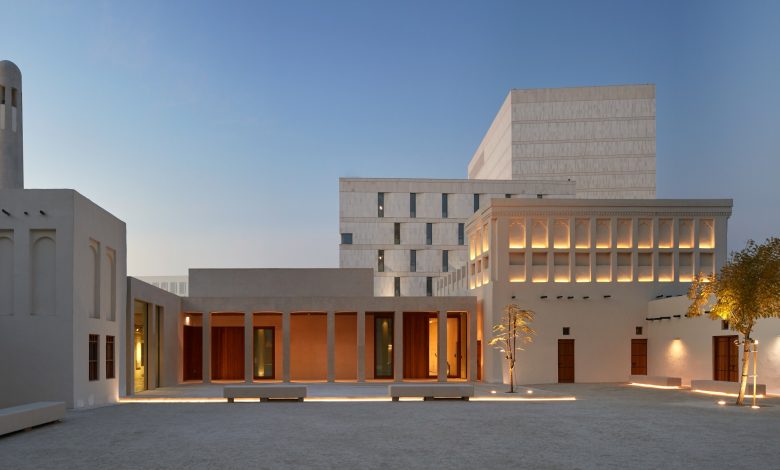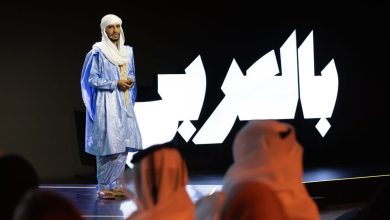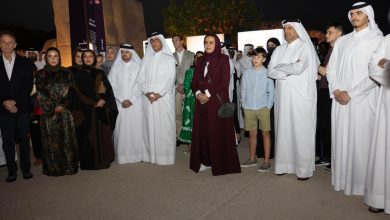
Slavery museum’s mission more vital than ever
مهمة متحف العبودية أكثر حيوية من أي وقت مضى
The Peninsula – Doha:
As protests against racism and police violence continue around the world following the death in the US of George Floyd, a 46-year-old black man, the mission of a slavery museum located 7,000 miles away in Doha has become all the more important.
“It’s very important to understand the history of racism, because history repeats itself,” said Dr. Hafiz Ali Abdulla, Director of Msheireb Museums, adding that for anyone around the world to empathize with the Black Lives Matter movement, it’s important to understand the root of the racism, which began with slavery but continued well beyond the official abolishment of slavery.
Founded in 2015 on the site of a former slave trader’s house where slaves from across the Indian Ocean were traded as recently as the early 20th century, the museum aims to raise awareness about the Arab world’s buried history of slavery. Named Bin Jelmood House, the museum is one of the four historic houses turned into exhibition spaces by Msheireb Museums, a project of Qatar Foundation’s subsidiary Msheireb Properties.
“It’s important to understand how racism works as a result of slavery, not just in the US, but also in other places,” said Fahad Al Turky, Exhibitions Manager at Msheireb Museums. “The museum is an opportunity to understand that there is global anti-blackness that is connected to slavery, as well as various other complex historical processes, such as colonialism and capitalism.”
The museum shines a rare light on the subject of slavery in the Middle East, which is often missing from public discourse because of the extreme sensitivity of the topic. However, according to Turky, recognizing a problem is the first step to finding a solution for it. “It’s important to look within our own communities,” he said. “At the end of the day, if you don’t address the historical injustices and other ills within societies, like racism, it only makes it more entrenched within a society, and makes it more difficult to achieve justice.”
The United Nations (UN) Special Rapporteur on Contemporary Forms of Racism also lauded the museum during her visit to the country last year.
“I wish to commend the museum for the powerful and crucial contribution to Qatar and the world more broadly. As is the case in all nations, Qatar’s past is vital for understanding its present and shaping its future,” read the rapporteur’s report to the UN, praising the country’s use of “arts, culture and sports to shift societal values, beliefs and perceptions fundamental to equality and non-discrimination.”
One of the exhibitions within the museum, titled Journey to the Heart of Life, looks at the DNA and genetics of a diverse group of people in Qatar to highlight how, biologically, all humans are similar to one another and come from the same origins.
“Race is a social construct, not necessarily a genetic or a scientific concept. The DNA exhibition shows that we have much more in common than we are different. So how is it possible that we can we exercise racism or slavery on each other?” said Turky.
Turky noted that while race is not a scientific phenomenon, racism is real and oppresses the lives of so many people around the world because of the society’s perceived notions of race.
“Museums such as the Bin Jelmood become a site of learning, and we give a different kind of narrative that is oftentimes not talked about,” added Turky. “And this is really important for awareness because once you understand this narrative or alternative history, you become more aware of the intersection of slavery, institutions, race, gender, and so on.
“Museums play a vital role in informing these discussions, and they are often the first step in starting those discussions.”
Msheireb Museums regularly work with educational institutes across the country to ensure important conversations about discrimination, slavery, and human exploitation also get discussed within classrooms. The museum has established the Msheireb Museums Friends program, which trains teachers and leaders from educational organizations and youth associations to become cultural ambassadors of its message and engage with its content both within and outside the museum.
In 2018, the International Council of Museums (ICOM) awarded Msheireb Museums with the Best Educational Practice award for their educational and cultural activities.
“This museum is a live document of what is happening around us and we are always working on enhancing the content and outreach of the museum that can help us improve any aspect of the society or the future,” said Dr. Abdallah.
As educational institutions start opening up after the COVID-19 lockdown is lifted, the museum’s team plans to collaborate more actively with schools and universities to continue the conversations on race and discrimination that have become all the more important in light of the protests starting from the United States.
Source: thepeninsulaqatar
الدوحة ـ الشرق:
مع استمرار الاحتجاجات العالمية ضد العنصرية عقب وفاة جورج فلويد في الولايات المتحدة الأمريكية، وهو رجل ذو بشرة داكنة يبلغ من العمر 46 عامًا، باتت مهمة متحف “بن جلمود” بالتوعية حول تاريخ الرق الذي يقع على بعد 7000 ميل في الدوحة أكثر أهمية.
شُيّد متحف بيت بن جلمود في عام 2015 على بقعة كانت في الماضي منزلًا لأحد تجار الرقيق في الدوحة، حيث كانت تتم المتاجرة بالعبيد من جميع أنحاء المحيط الهندي في أوائل القرن العشرين. يهدف المتحف إلى رفع مستوى الوعي حول تاريخ الرق العربي المدفون. ويُعرف المتحف باسم “بيت بن جلمود”، وهو أحد البيوت التاريخية الأربعة التي تحولت إلى متاحف على يد مشيرب العقارية التابعة لمؤسسة قطر.
يركز أحد المعارض في المتحف بعنوان “رحلة إلى نواة الحياة” على الحمض النووي وعلم الوراثة لمجموعة متنوعة من الأفراد في قطر، لتسليط الضوء على كيفية تشابه جميع البشر، من الناحية البيولوجية، وكونهم يأتون من الأصول نفسها.
جذور العنصرية
يقول الدكتور حافظ علي مدير متاحف مشيرب، التي تدير بيت بن جلمود: “من المهم جدًا فهم تاريخ العنصرية، لأن التاريخ يعيد نفسه”، مشيرا إلى أنه لكي يتعاطف أي شخص حول العالم مع الحركة التي نشأت في العالم والتي تطالب بمكافحة العنصرية، من المهم فهم جذور العنصرية التي بدأت بالعبودية ولكنها استمرت إلى ما بعد إلغاء الرق رسميًا.
وأضاف قوله: “إن هذا المتحف هو وثيقة حية لما يحدث من حولنا، ونحن نعمل دائمًا على تعزيز محتواه وزيادة التوعية حوله، ما قد يمكننا من تحسين أي جانب من جوانب المجتمع أو المستقبل”.
وختم د. حافظ علي قائلا: “نحن لا نحاول تحديد من كان على خطأ أو على صواب. نحن نحاول فقط إظهار السمات الأساسية لكوننا بشرًا والتي نتشاركها جميعًا، ونرسخ حوارًا حول عدم وجود تفوق لعرق على آخر”.
عوامل تاريخية
من جانبه، قال فهد التركي، مدير المعارض في متاحف مشيرب: “من المهم أن نفهم كيف قادت العبودية إلى العنصرية، ليس فقط في الولايات المتحدة الأمريكية، ولكن أيضًا في أماكن أخرى”. مضيفا: “المتحف فرصة لفهم أن المعاداة العالمية لذوي البشرة الداكنة مرتبطة بالرق، بالإضافة إلى العديد من العوامل التاريخية المعقدة الأخرى، مثل الاستعمار والرأسمالية”.
وأضاف قائلا: “من المهم أن ننظر داخل مجتمعاتنا. في نهاية المطاف، إذا لم تعالج المظالم التاريخية والاختلالات الأخرى مثل العنصرية، فإنها ستصبح أكثر رسوخًا داخل المجتمعات، ويصبح من الصعب تحقيق العدالة”.
ويضيف فهد التركي قوله: العرق هو بناء اجتماعي، وليس بالضرورة مفهومًا جينيًا أو علميًا. يُظهر قسم الحمض النووي في أحد المعارض في المتحف أن القواسم المشتركة التي تجمعنا أكثر من تلك التي تجعلنا مختلفين. إذن كيف يمكن نمارس كبشر العنصرية أو العبودية على بعضنا البعض؟.
وتابع: “أصبحت بعض المتاحف مثل متحف بن جلمود موقعًا للتعلم، حيث نسرد القصص التي غالبًا ما لا يتم الحديث عنها، بشكل مختلف. وهذا مهم حقًا للتوعية لأنه بمجرد أن تفهم هذا السرد أو التاريخ البديل، تصبح أكثر وعيًا بتقاطع العبودية والمؤسسات والعرق والجنس وما إلى ذلك؛ إذ تلعب المتاحف دورًا حيويًا من خلال إثراء المناقشات حول هذه القضية، وغالبًا ما تكون الخطوة الأولى في بدء هذه المناقشات”.
كما يسلط المتحف الضوء على تاريخ الرق في الشرق الأوسط، والذي نادرًا ما يرِد في الخطاب العام لكونه موضوعًا يتسم بالحساسية الشديدة، ومع ذلك، وفقًا لفهد التركي، فإن إدراك المشكلة هو الخطوة الأولى لإيجاد حل لها.
بدورها، أشادت إي تندايي أتشيومي، المقررة الخاصة للأمم المتحدة المعنية بالأشكال المعاصرة للعنصرية بالمتحف خلال زيارتها للبلاد العام الماضي، مثنية على المتحف لمساهمته القوية والحيوية في دولة قطر والعالم على نطاق أوسع، معتبرة أنه “كما هو الحال في جميع الدول، فإن ماضي قطر حيوي لفهم حاضرها وتشكيل مستقبلها”. كما أشادت المقرر في تقريرها المقدم إلى الأمم المتحدة، باستخدام البلاد “للفنون والثقافة والرياضة لتغيير القيم المجتمعية والمعتقدات والتصورات الأساسية في المساواة وعدم التمييز”.
جدير بالذكر أن متاحف مشيرب تعمل بانتظام مع المعاهد التعليمية في جميع أنحاء البلاد لضمان إقامة النقاشات الهامة حول التمييز والعبودية والاستغلال البشري أيضًا داخل الفصول الدراسية. وقد أنشأ المتحف برنامج “أصدقاء متاحف مشيرب”، الذي يهدف إلى تشكيل مجموعة من السفراء الثقافيين من خلال تدريب عدد من المدرسين والطلاب والقادة من مختلف المؤسسات التعليمية والشبابية، لنشر رسالته وللتفاعل مع محتواه داخل وخارج المتحف. وفي عام 2018، منحت لجنة المتاحف الدولية للأنشطة التعليمية والثقافية المجلس الدولي للمتاحف، جائزة أفضل برنامج للممارسات التعليمية لأنشطتها التعليمية والثقافية.
المصدر: al-sharq



